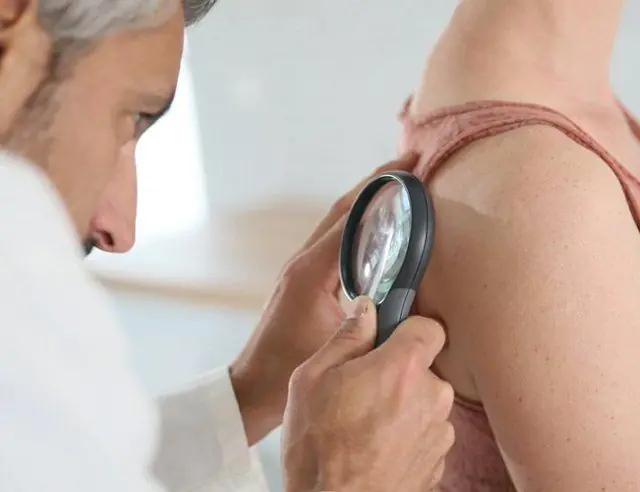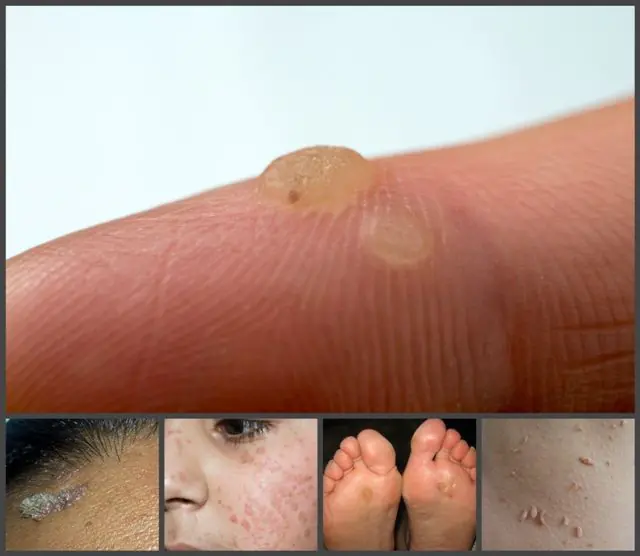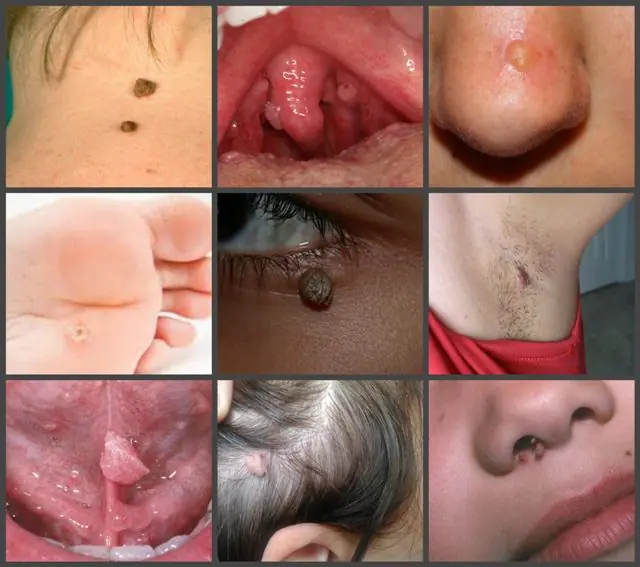
- Size of papillomas on the body
- Main types
- Localization of papillomas
Papillomas on the body are small neoplasms, most often benign, caused by the activity of papillomavirus in the human body. They are usually divided into several types - according to location, size and type. There are flat, filiform, plantar, simple and pointed formations, each of which has its own appearance and distinctive features.
Size of papillomas on the body

Photo of papillomas on the body
Speaking about what types of papillomas there are on the body, first of all it must be said that they divided into small and large, which does not require much explanation. The size of the former usually does not exceed 0.5 cm, while formations of the second type can reach 1-2 cm. Basically, here we are talking about condylomas localized on the genitals or face.
Papillomas tend to increase in size over time, as the virus that caused their appearance becomes more active. The longer they are on the body, the higher the likelihood of this happening. The least common are usually flat formations adjacent to the skin.
The hanging type of papillomas on the body can be small or large; the former are most often found under the armpits, on the shoulder, chest, and abdomen. Growths of the second type are often found on the neck and even on the head, in the hair. Although there are exceptions to the rules, there is no exact data here.
Note! Papillomas can be single or multiple; in the latter case, they sometimes visually merge into large spots, creating the appearance of integrity.Main types of papillomas on the body

Photos of different types of papillomas on the body
In medical practice, it is customary to distinguish 5 types of papillomas on the body: simple, flat, filiform, plantar and pointed, called condylomas. One formation cannot belong to different species, and externally it can be easily recognized by shape, size, color and a number of other characteristics.
Let's take a closer look at what types of papillomas there are on the body:
- Simple. They are usually caused by papillomavirus types 2 and 4, which also provokes the appearance of warts. The reason for their formation is the active activity of HPV. First, dots appear on the body that slightly stand out against the general background, which then turn into papules, become covered with a dense crust and become rough. Their size is most often 3-10 mm. This type of papillomas on the body is not dangerous for humans, since it is rarely oncogenic and almost never degenerates into malignant. If there is a small amount on the body, there is no need to remove them, unless, of course, the appearance is spoiled. They mostly occur between the fingers, on the palms and face - on the chin, near the lips and above the eyebrows. Laser therapy is the best method for removing such growths.
- Plantar warts. Usually they are placed in a separate group, but in appearance they are very similar to simple papillomas and appear due to the active activity of HPV types 1, 2 and 4. This type of papilloma on the body in the photo looks like flat dots, most often brown in color, with a rounded shape and unclear boundaries. Their diameter is on average 1 cm, but it can be larger or smaller. In some cases, small blisters and redness can be seen around these growths. Also, quite often a person is bothered by itching and irritation of the skin. Plantar warts have deep roots containing nerve endings. These formations are benign and non-tumorigenic; they do not become malignant. Their peculiarity is the high probability of spreading to other areas. Regardless of what kind of papillomas there are on the body, photos of patients show that they are rarely localized on the face. Warts can be located on the feet, between the toes and hands. The best way to remove these growths is to use a laser and liquid nitrogen.
- Filiform. They received this name because of their convex shape. These growths stand out against the background of the skin, rising above the surface by several millimeters or even centimeters. These neoplasms resemble an unopened bud, their color is beige, pale pink and light brown, their size is about 1 cm. Over time, judging by the photo of the types of papillomas on the body, they turn yellow and increase in diameter, and their stem becomes stronger. They have the strongest root, so it is not always possible to remove it the first time. To do this, it is recommended to use either a radio knife or a laser device. Threaded papillomas are most often localized in the axillary area, on the neck, chest and groin, and are sometimes found on the eyelids. Their peculiarity is the high probability of injury, since they easily cling to clothing. The result is bleeding and inflammation, and the risk of infection also increases.
- Flat. Their occurrence is associated with infection with papillomavirus types 3 and 10. Teenagers are most susceptible to their appearance, since they often experience malfunctions of the immune system. Externally, these growths look like small round-shaped formations that can be localized throughout the body and even the face. Most often, this type of papillomas on the body affects the neck, face, arms, and genital area. In some cases, they can appear on internal organs, for example, the cervix or rectum. Their size usually does not exceed 5 mm, so visually they are not very noticeable. Their color is usually yellow, flesh-colored or pale pink, the surface is uneven and rough. Very often they are located nearby, grouped in several pieces. Their danger lies in the high likelihood of inflammation, itching and pain. Electric current and laser therapy are usually used to remove them.
- Pointed. Such papillomas are correctly called condylomas; they grow under the influence of HPV 6, 11, 16 and a number of other types. This is the most dangerous type of papillomas on the body, since it is highly oncogenic and is easily transmitted from person to person during sexual intercourse or kissing, depending on the location. You can also suffer from it during childbirth, in which case the child becomes the carrier of the virus. These growths can form on the external genitalia and eyelids, on the face. They are easily recognized by their cauliflower-like shape, they have the same uneven surface, and their color is usually pink or flesh-colored. The size of the growths can reach 2 cm. Their feature is a single distribution; multiple genital warts are extremely rare. Symptoms of such formations are pain, itching, bleeding, mild burning and discomfort in the area where they are located.
Localization of papillomas on the body

Formations of this type can be located both in a person’s field of vision, on the skin, and on any internal organs. The latter include growths located, for example, on the tongue, tonsils, mucous membranes and other areas in the oral cavity. This causes severe discomfort, which prevents you from eating and drinking water normally. It is these papillomas that pose the greatest danger to humans, since through a kiss, HPV can easily penetrate into a healthy body.
The internal appearance of papilloma on the body is also often localized on the walls of the rectum. Externally, they look like growths on the mucous membrane, protruding several centimeters above the surface. Their danger lies in the possibility of degeneration into malignant formations and the development of oncology. Also, sometimes this leads to disruption of stool due to partial closure of the lumen inside.
The most common is papilloma on the cervix, and, as we said earlier, genital warts most often appear here. They have a high degree of oncogenicity and require increased attention. Their presence is dangerous for a sexual partner, as it threatens infection.
In rare cases, papillomas grow on the walls of the bladder and stomach. In such a situation, they can lead to bleeding and discomfort, and worsen the functioning of these internal organs. They are usually treated therapeutically, but if the desired results cannot be achieved in this way, they undergo surgery.
The external appearance of papillomas on the body is easy to diagnose, since the growths are easy to notice with the naked eye. They can be located on absolutely any part of the body or face.
Common places for their localization are the neck, arms, legs, in particular fingers, palms, elbows, armpits, and shoulders. Sometimes they grow on the stomach, chest, above the eyebrows, near the lips, on the nose. There are known cases of growths forming on the head, in the hair, and even in the ears.If the papilloma is located externally, treatment with external means - solutions, sprays, ointments, creams, gels, etc. is justified. Only if they do not help, should you think about carrying out physiotherapeutic procedures, and even more so about surgical intervention.
What types of papillomas are there on the body - look at the video:
Regardless of what kind of papillomas there are on the body, when they appear, it is necessary to urgently take all necessary measures. First of all, you should contact a dermatologist, oncologist, virologist and immunologist. They will conduct a thorough examination and rule out malignancy of the formation. After this, a decision will be made on therapeutic or surgical removal of the growth.
- Related article: How to distinguish a mole from a papilloma



